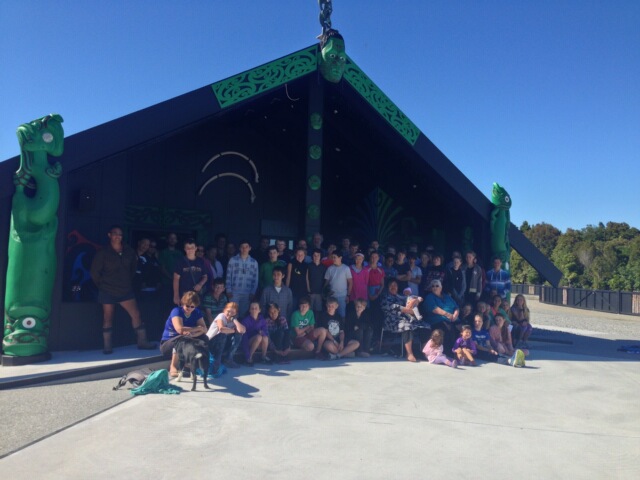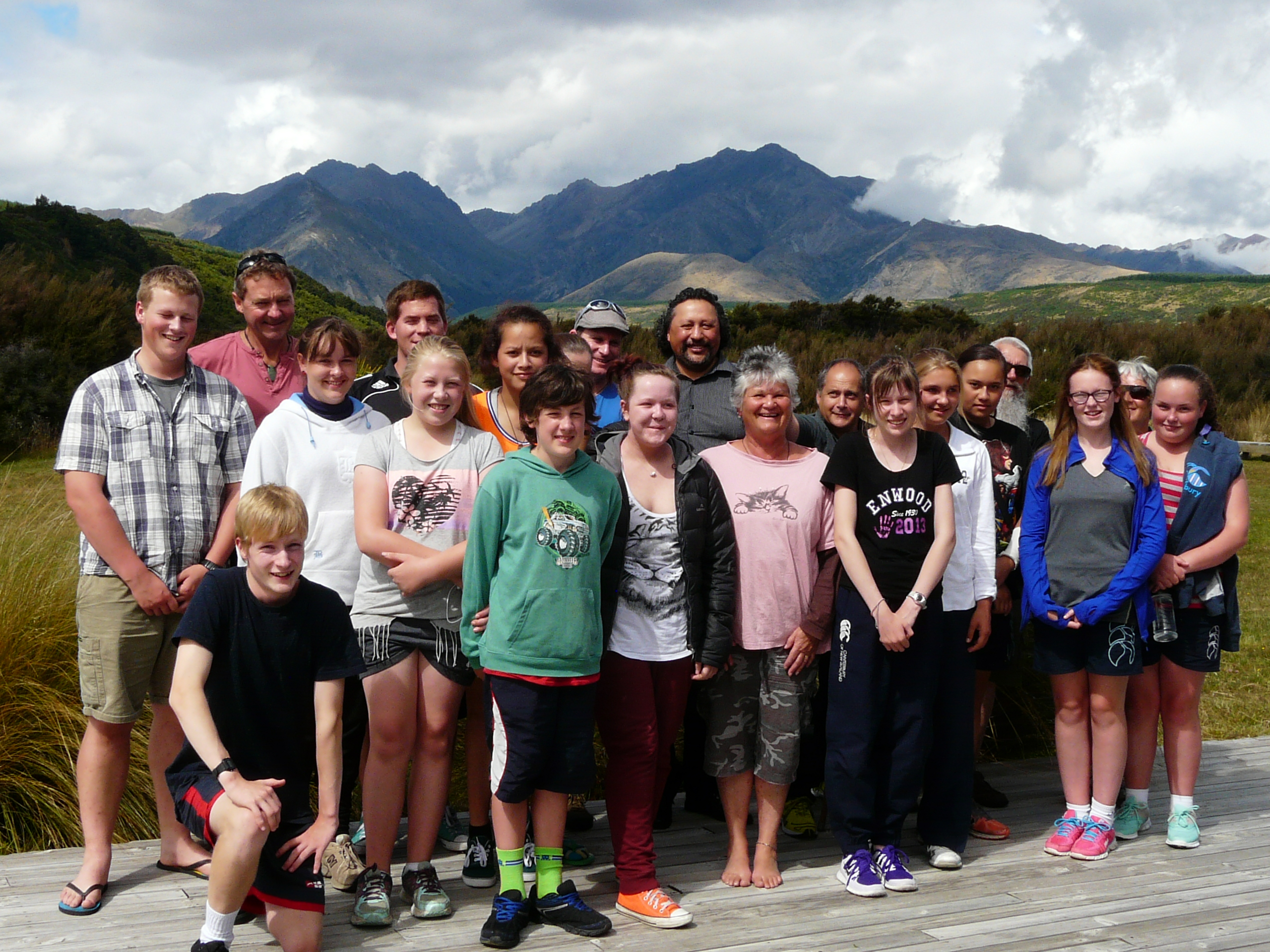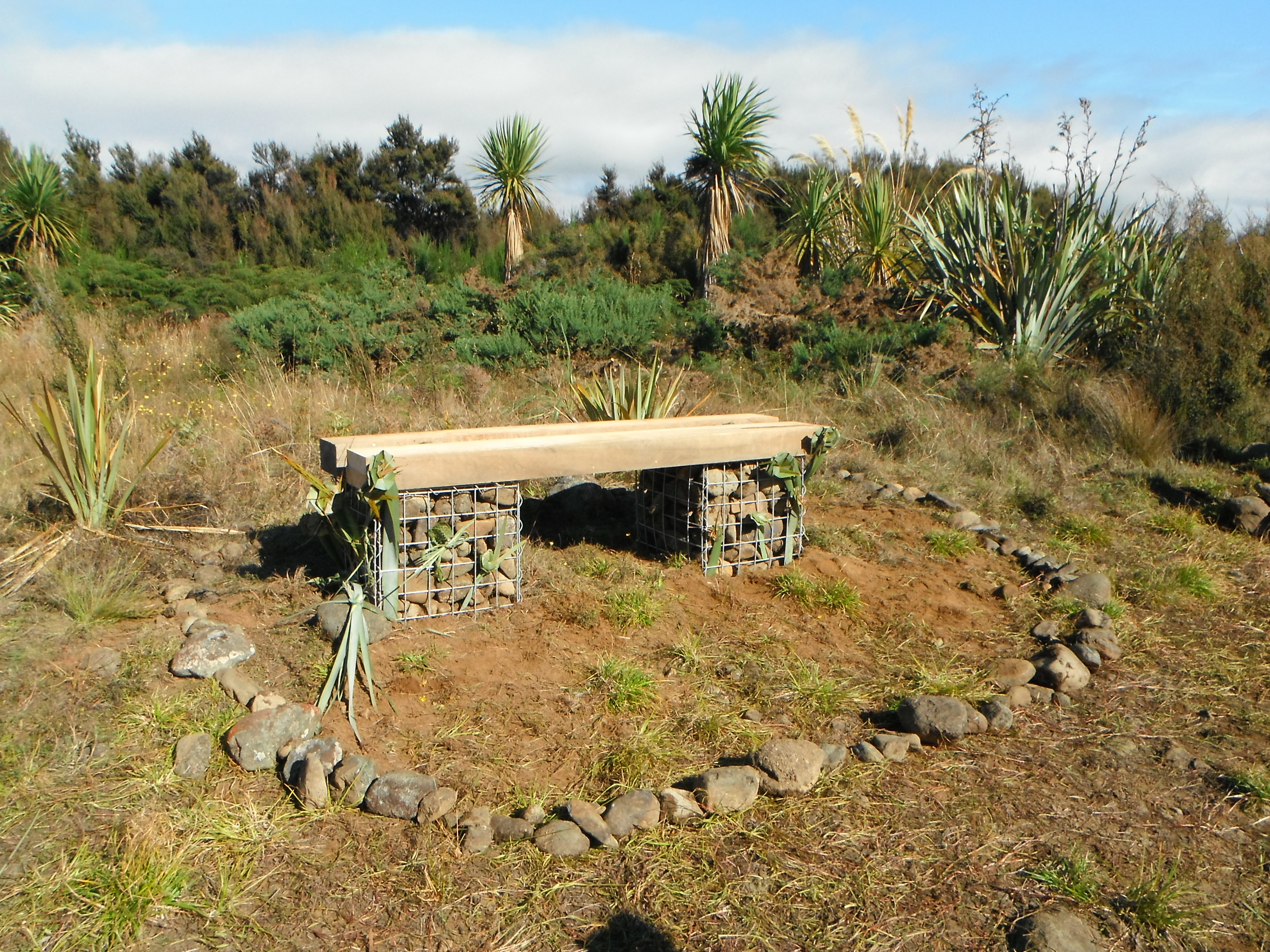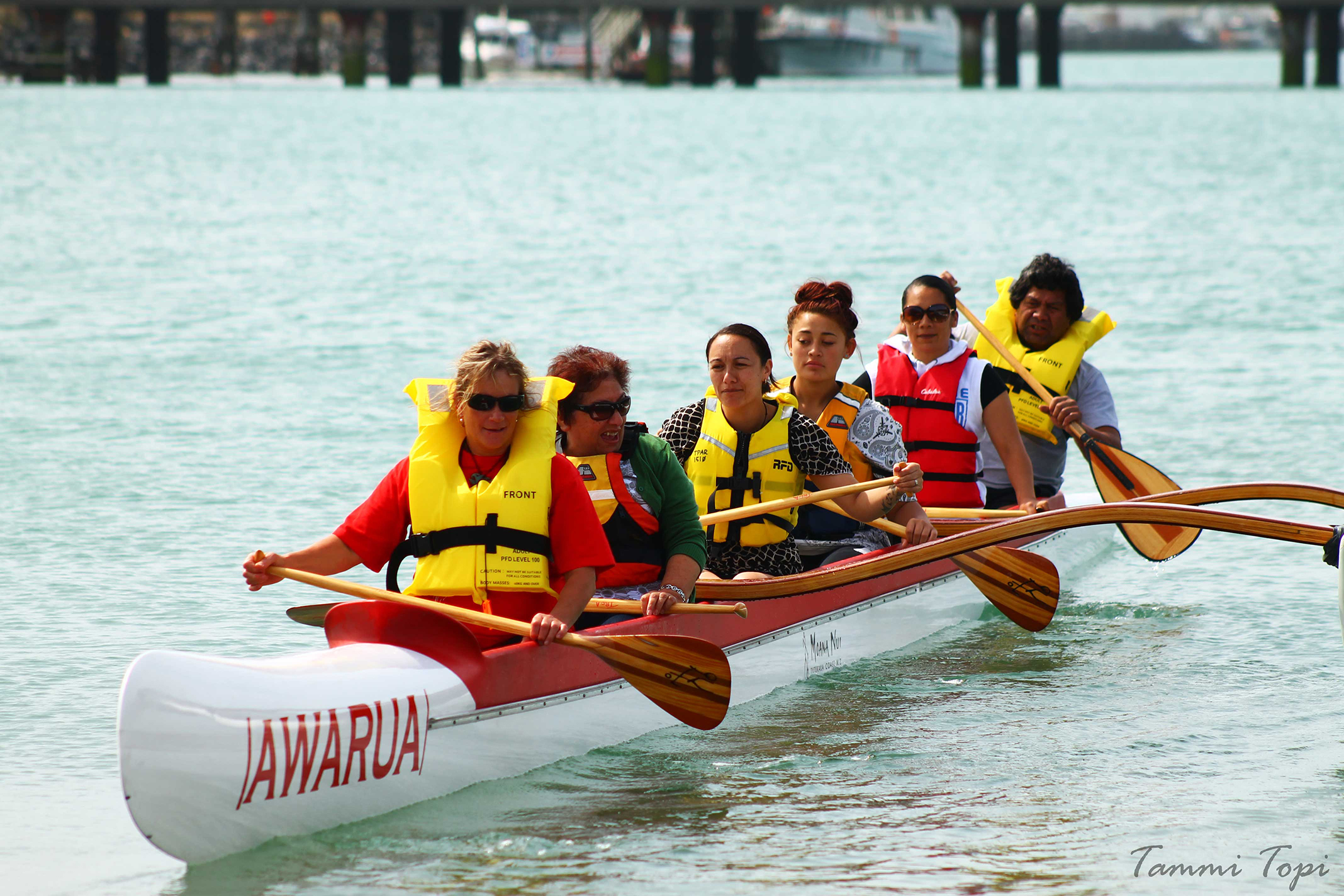He pēpi
Justin and Serena Solomon welcome their little princess, Kaia Alice-Maree Solomon who was born on 9 February, weighing 8Ib 5oz. Kaia is little sister to James and a new mokopuna for Mark and Maria Solomon.

Kaia Alice-Maree Solomon.
Wai Ora Montessori School
On 7-10 February, we had the pleasure of hosting a kura from Lower Hutt. There were 47 students and six teachers in total. The purpose of their trip was to study coal mining, gold mining and the sourcing of pounamu. We look forward to them returning every year.

The Montessori School group.
Whio release
On 12 February, whānau and the Arahura Kōhanga and one of our local schools, Kaniere Primary welcomed the Department of Conservation and five whio (blue ducks) to our marae for a talk about these beautiful manu.
Everyone gathered in the boardroom quietly to listen to their beautiful call and we were also fortunate enough to each pat a whio.
After the kids got to have a pat and a talk, Hamiria and myself got to go in a helicopter to release them up the Arahura river at the mud flats. It was an awesome experience to release them on our awa and to watch them finally hit our waters after we opened the boxes to let them out.
I can’t wait until we have another opportunity to do it again.

Tamariki patting the whio.

Everybody was happy to see the whio.
Waiau blessings
On 28 February, our rūnanganui (executive team) met at our marae. On the way down on Friday afternoon, we met with a large group of local Waiau (Franz Josef) community members and Kidsfirst representatives to bless the site next to the Franz Josef School where they will be building their new centre – a beautiful site.
The blessing was carried out by Upoko Rūnanga, Venerable Rev Richard Wallace, with rūnanga members in support.
We returned to Waiau on Sunday, 1 March and we joined Ngāi Tahu Tourism, Franz Josef Glacier Guides and hot pools staff to bless their new building, fronting Cron Street in front of the hot pools.
This is stage one of a two-section building. The next stage is due to start this month with the Department of Conservation area being built.
The blessing, carried out by Upoko Rūnanga, Venerable Rev Richard Wallace supported by Māhaki whānau, allows the Glacier Guides and Hot Pools staff to begin operating from the building. Kōwhaiwhai adorn the top windows, and inside the entire mezzanine wall is covered with a wonderful historic shot of people on the glacier in 1906.
The building has been named Te Ao Mārama, which was the name given by our tīpuna, Te Koeti Tūranga to explain the myriad of colours he and his men encountered while exploring for gold within the cave then at the base of Franz Josef Glacier. Of course it was the sun and light reflecting through the icy glacier.

Franz Joseph School preparing to sing a waiata to Upoko Rūnanga, Richard Wallace, Tumuaki, Susan Wallace and kaiāwhina, Rachael Forsyth.
He pēpi
Nau mai haere mai, Tamati York Pearson, who was born on 24 December 2014.
Congratulations to Robyn Meehan and Mat Pearson on their new arrival.

Baby Tamati.
Enviroschools trip
For two days during February, 15 young environmental leaders participated in a wānanga which introduced them to concepts of whakapapa, kaitiakitanga, mauri and manaakitanga at Te Kōawa Tūroa o Takitimu.
The programme was the first of its kind for these students and was supported by a local team which included Ōraka Aparima Rūnaka, Ngāi Tahu whānau, Enviroschools Foundation, Environment Southland Environmental education team, Department of Conservation and Resource Teachers of Māori.
The students were selected as representatives of the three southland secondary Enviroschools.
Following the mihi whakatau we tuned into the mahi by sharing a small taonga we had each brought with us, placing them on a large map sharing the story. Later in the afternoon we shared kōrero with Victor and Dave about Te Ao Māori, Te Kōawa Tūroa, whakapapa, kaitiakitanga, mauri and manaakitanga.
Following this we went on a hīkoi up the valley sharing more kōrero and thinking about a scoring we would give to represent its mauri. This was a challenging exercise which was used to encourage some critical thinking about different environments and impacts they face and the roles we can all play to nurture them.
In the evening the students discovered more about whakapapa with Lydia who provided a great take-home resource for them as well.
On the morning of the second day we all ventured back up the valley where our mahi was to build a seat that overlooked the second pond and Takitimu. Everyone played a part in locating the site as well as building and decorating the seat. There was a lot of fun and sharing together as gabion baskets were built, sleepers were carried in, rocks were gathered, harakeke flowers were made, gorse was cleared, cairns were built and the seat was levelled and tested by all 15 students having to fit on it at one time.
Each school had also brought some tī kāuka as koha so these were planted in the area behind the seat.
During this time we also discussed the importance of naming the seat. The students suggested the name should include the fact that the seat was built by young people for a place for young and old to sit and reflect, as well as observing the reflection of Takitimu in the pond. The name will be left for the rūnaka to develop in te reo further.
This was a wonderful wānanga for all who attended and helped in so many ways and the partnerships and cooperation made the learning all the more real for us all. Nā Mark Oster.

The Enviroschools group.

The seat that was made by the rangatahi.
Waka launch
What a difference a couple of days made. The Sunday dawned and it was sunny and although the wind came up for a bit in the afternoon, and it became overcast it was fine enough to launch our waka with whānau and members of other waka ama rōpū.
Our waka was christened with a fine kōrero and karakia from Te Rūnanga o Awarua Upoko, Tā Tipene O’Regan and Dean Whaanga. Whānau who came along to join in our celebrations were treated to a barbeque and the chance to mingle and enjoy the company of others.
Young and old had a paddle and it has kindled an interest in those who wish to participate in waka ama.
If any one wishes to participate please contact the rūnanga office on 212 6020 or 212 6029.

Preparing to launch.

Whānau on-board the waka ama, Awarua.
Encouraging young Māori into science
A University of Canterbury scheme aimed at encouraging Māori secondary school students into university science studies is already changing lives and encouraging rangatahi to consider new pathways for their future.
He Puna Pūtaiao is a partnership programme between the University of Canterbury College of Science and several Canterbury secondary schools that began in 2013. Based on a scheme delivered by LENScience at the Liggins Institute in Auckland, He Puna Pūtaiao engages Year 10 Māori students in the culture of science by involving them in scientific research.
Using the context of the water quality in Te Waihora/Lake Ellesmere, the students are mentored in literature reviews and collecting and analysing data in the field, before presenting their findings both in e-book format and a research poster displayed at a Pō Whakanui at the end of the programme.
The partnership schools – Cashmere High School, Burnside High, Linwood College and Lincoln High School – all select nine Year 10 Māori students to attend the intensive six-week programme during October and November, which includes weekly visits to the University of Canterbury and a field trip to Te Waihora.
John Pirker (Ngāi Tahu), Māori Advisor to the UC College of Science, says partnership schools and students’ whānau have been heavily involved in the planning and partnership since it began. A science teacher from each school attends the programme with the students, and post-graduate students and staff from University of Canterbury science departments volunteer their time to mentor students during each week of the programme.
“That’s been a pivotal role and one that’s had an enormous effect on the students,” says John Pirker.
“Being mentored by some of our post-graduate students has been very inspiring for the school students. They’ve been mixing with university students, visiting lecture theatres and learning that university isn’t a scary place.
“That, coupled with the research work they do around Te Waihora water quality, shows them that they can achieve in a university environment if they choose to.”
University of Canterbury Science Outreach Coordinator, Joan Gladwyn says He Puna Pūtaiao has had a very positive response from school staff and students alike.
“Many of the students who’ve done the programme talk about gaining confidence and an interest in science,” she says.
“As a result of the course, they can see that a career in science is an achievable goal for them. The programme is about exposing them to opportunities and it’s definitely working. Some of these students had never heard Māori and science talked about together before.”
John Pirker says that Te Waihora was an obvious study choice, especially given that one of the schools (Lincoln) is within the Te Waihora catchment.
“We have the support of Te Taumutu Rūnanga, Environment Canterbury, the Department of Conservation and the Waihora Ellesmere Trust for the students to work around the lake, and with the number of co-management plans involved in Te Waihora restoration, it’s a perfect example of Mātauranga Māori and western science working together to remediate the lake,” he says.
In addition to testing Te Waihora water quality, the students also learn about the lake’s history and mahinga kai practices, and they meet Taumutu kaumātua; their site visits have also included interactions with bird experts and practising scientists.
“I’m pleased to say the students can already see the need to drive these restoration projects forward for iwi Māori and the wider community. They can see the need for Māori to have a voice within science. We’re excited about that.
“If they go ahead with university science studies there are good job prospects and leadership roles there if they want them.”
Joan Gladwyn says it’s very rewarding to see He Puna Pūtaiao is already having such a positive effect on students.
“We know we’re making a difference and if the Auckland programme our scheme is based on is anything to go by, we’ll continue to see significantly more young Māori going into university science studies. That’s very satisfying because these young people are our future and they have a voice that needs to be heard.
“He Puna Pūtaiao is all about igniting fires, inspiring people and changing lives. We’ve had students tell us that the programme has opened their eyes to what they are actually capable of doing. That’s always rewarding.”

Isaac Wilson Cashmere High and post-grad mentor Channell Thoms (Ngāi Tahu).
Guardians of the future
The Te Ana Ngāi Tahu Rock Art Centre is placing a stronger focus on the education sector in the hope of raising the profile of ancient rock art and encouraging a new generation of rock art guardians.
In 2014, 3,420 school children from 33 schools took part in Te Ana activities and Te Ana Ngāi Tahu Rock Art Centre curator, Amanda Symon says they hope to build on this in 2015.
“With a new focus on outlying areas, we had children from as far afield as Ashburton and Ōāmaru, and a broader scope that included pre-schools, school holiday providers, polytechs and wānanga,” says Amanda.
“We had excellent feedback from the schools, who say they have received great value from high quality learning experiences based on this aspect of local mana whenua culture.”
She says that the school children of today are the landowners of tomorrow and probably the biggest thing the Te Ana Ngāi Tahu Rock Art Centre can do to protect the sites into the future, is to educate children and build their awareness of the significance of the early artwork.
“Our work is to educate our wider communities, especially children – firstly about the presence of this amazingly significant taonga in their backyards, and then how they can have a role in protecting it. To that end, we have built a range of activities to help increase understanding of the rich Māori history of our region, and to support and promote the kaitiaki roles of Papatipu Rūnanga in our district.”
Those events have included a wide range of activities centred around key days and celebrations like Waitangi Day and the annual Matariki Festival. In 2014, a new learning module based around Puaka, the star that heralds the coming of the Māori New Year in Te Waipounamu, was developed. More than 750 children took part in the module, which led into Te Ana’s annual Puaka-Matariki celebration in June.
Aside from the income generated from these activities, (which is used to protect and manage rock art sites), Amanda says the social and cultural outcomes promoting and celebrating Ngāi Tahu culture within the South Canterbury community is significant.
The Ngāi Tahu Māori Rock Art Trust was established in 2002 to support rūnanga and their communities in the care, management and interpretation of their Māori rock art heritage. The main objectives of the Trust are to ensure the preservation and protection of Māori rock art for the benefit of Ngāi Tahu whānui, and for all New Zealander’s, and to take a leading role in the conservation and management of rock art throughout Ngāi Tahu’s tribal boundaries.
For Amanda, today’s school children are a logical focus for the Te Ana Ngāi Tahu Rock Art Centre. Of the 6040 people who visited the centre in 2014 (an increase of more than 50% on the previous year), 3,420 were school children.
“There’s a lot of support from schools to know about mana whenua culture and rock art is a very real aspect of that that kids can engage with. It’s a tangible way for them to get a grasp of a history that is important to all New Zealanders.”

Learning about rock art.

St Joseph’s Temuka and Te Ana staff visit the Māori rock drawings.

Encouraging tamariki to become the rock art guardians of the future.